12 Types of Mockingbird Species: An Overview (With Pictures)
Last Updated on
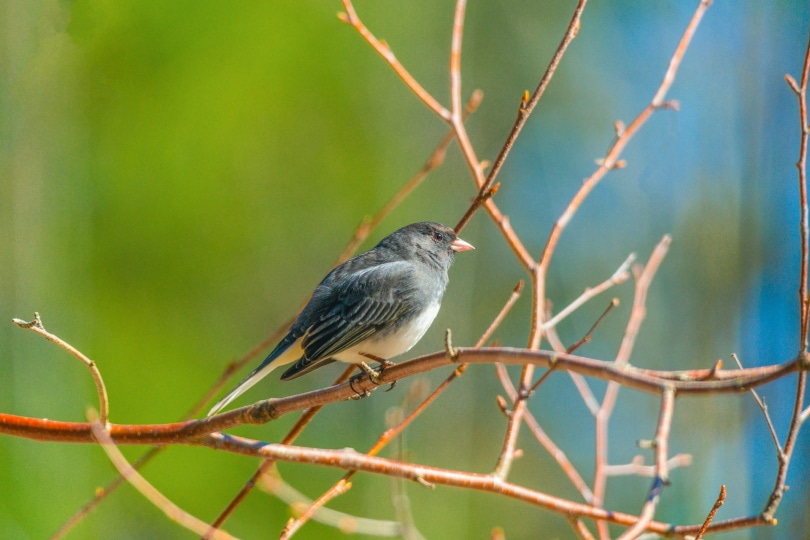
Are you interested in learning about the different types of mockingbird species? You may have seen one or two of these birds singing their hearts out without realizing that they were mockingbirds.
There are many different types of mockingbirds, but their cheerful melodies are something that they all have in common. Still, it’s crucial to understand their differences to identify each one.
They may look similar at first, but variations exist among them. A few of the known types of mockingbird species are listed below.

The 12 Types of Mockingbird Species
1. Northern Mockingbird
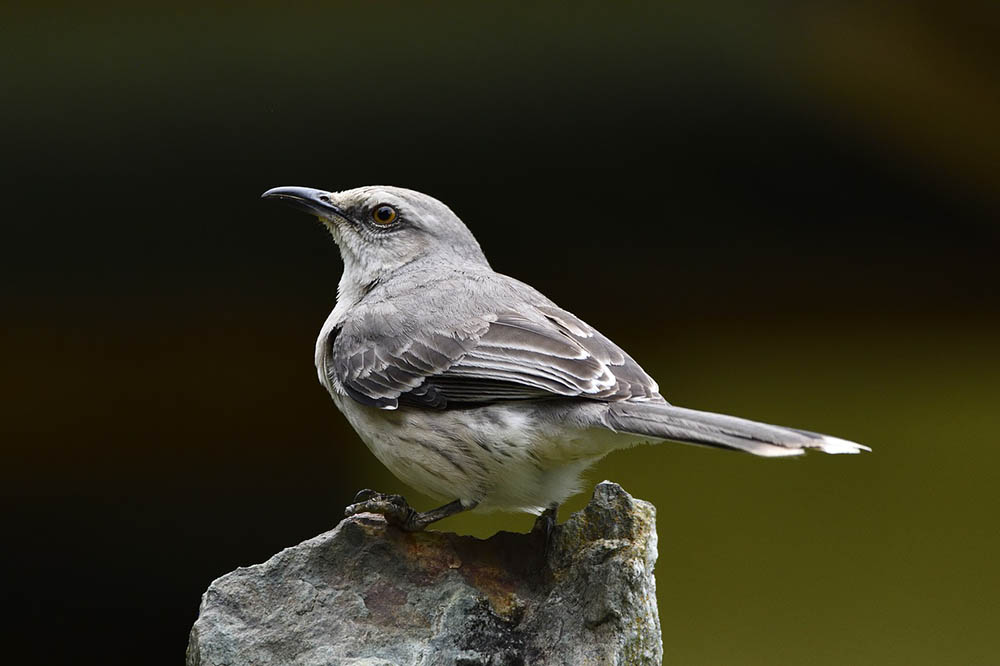
| Family: | Mimidae |
| Scientific Name: | Mimus polyglottos |
| Diet: | Insects in summer and fruits in fall and winter. |
| Where They’re Found: | United States, Mexico, and Canada. |
| Eggs Per Clutch: | 2–6 |
The most common mockingbird species is the Northern Mockingbird. These birds have gray feathers and white underbellies. They also have black eyes and long tails that sit low on their bodies. Their wingspan reaches about 1 foot wide.
These mockingbirds are a common sight in North America and are known for their territorial nature. The male Northern Mockingbird is known for chasing away cats, dogs, or other animals threatening its territory or nesting area.
The Northern Mockingbird has one of the most varied repertoires of any songbird. It can sing up to 200 different songs during the breeding season. It will even mimic the sounds of other birds, animals, and humans.
2. Tropical Mockingbird
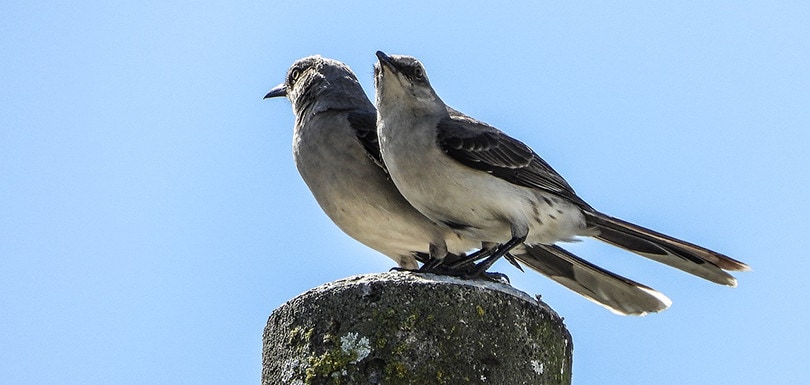
| Family: | Mimidae |
| Scientific Name: | Mimus gilvus |
| Diet: | Grasshoppers, spiders, seeds, berries, small fruits, and beetles. |
| Where They’re Found: | Southern Mexico and other Caribbean Islands. |
| Eggs Per Clutch: | 2–6 |
The Tropical Mockingbird is a small bird about 9 to 10 inches long with long legs and tails.
The Tropical Mockingbird is an omnivorous bird that lives in scrublands, savannas, and urban areas. The males are gray with a white wing patch on each wing and a white rump. The females are similar to the males, but their colors are less distinct, and they have whitish breasts. Both have black legs and feet and dark eyes.
Tropical Mockingbirds’ beaks have a downward curve at the end. It helps them eat insects and small invertebrates. Although they look similar, there are physical differences between the Northern Mockingbird and the Tropical Mockingbird, including their range, size, coloration, behavior, and voice.
3. Galapagos Mockingbird

| Family: | Mimidae |
| Scientific Name: | Mimus parvulus |
| Diet: | Centipedes, orthoptera, caterpillars, insects, cacti, fruits, and nectar. |
| Where They’re Found: | Galapagos Islands, Ecuador |
| Eggs Per Clutch: | 3–4 |
The Galapagos Mockingbird is the largest of the four species of mockingbirds found on the Galapagos Islands. They have long legs and large feet for running and catching prey. They also have long beaks for reaching into crevices to find insects. These Mockingbirds have a light gray color with a white underbelly.
Mockingbirds are known for their ability to imitate other birds’ songs. The Galapagos Mockingbird is no exception. These birds are excellent mimics and can also imitate many sounds from their environment.
The Galapagos Mockingbird makes its home in many habitats. It can be found mainly in forests and coastal areas. The nesting sites are tucked into crevices or hollows they’ve created. It’s challenging to spot them because they blend in well with their surroundings.
4. Hood Mockingbird

| Family: | Mimidae |
| Scientific Name: | Mimus macdonaldi |
| Diet: | Marine arthropods, insects, berries, fruits, and small vertebrates. |
| Where They’re Found: | Espanola Island |
| Eggs Per Clutch: | 4 |
The Hood Mockingbirds are only found in habitats with tropical dry forests or tropical moist lowland forests. It breeds at the end of the dry season, between January and April, and the nests look like a cup made of grass, stems, and leaves.
Hood Mockingbirds are among the most notable of all mockingbirds. You can identify them by the white patch on their throats. There’s also a little hood that covers their eyes.
They have a loud, musical singing voice.
5. Bahama Mockingbird
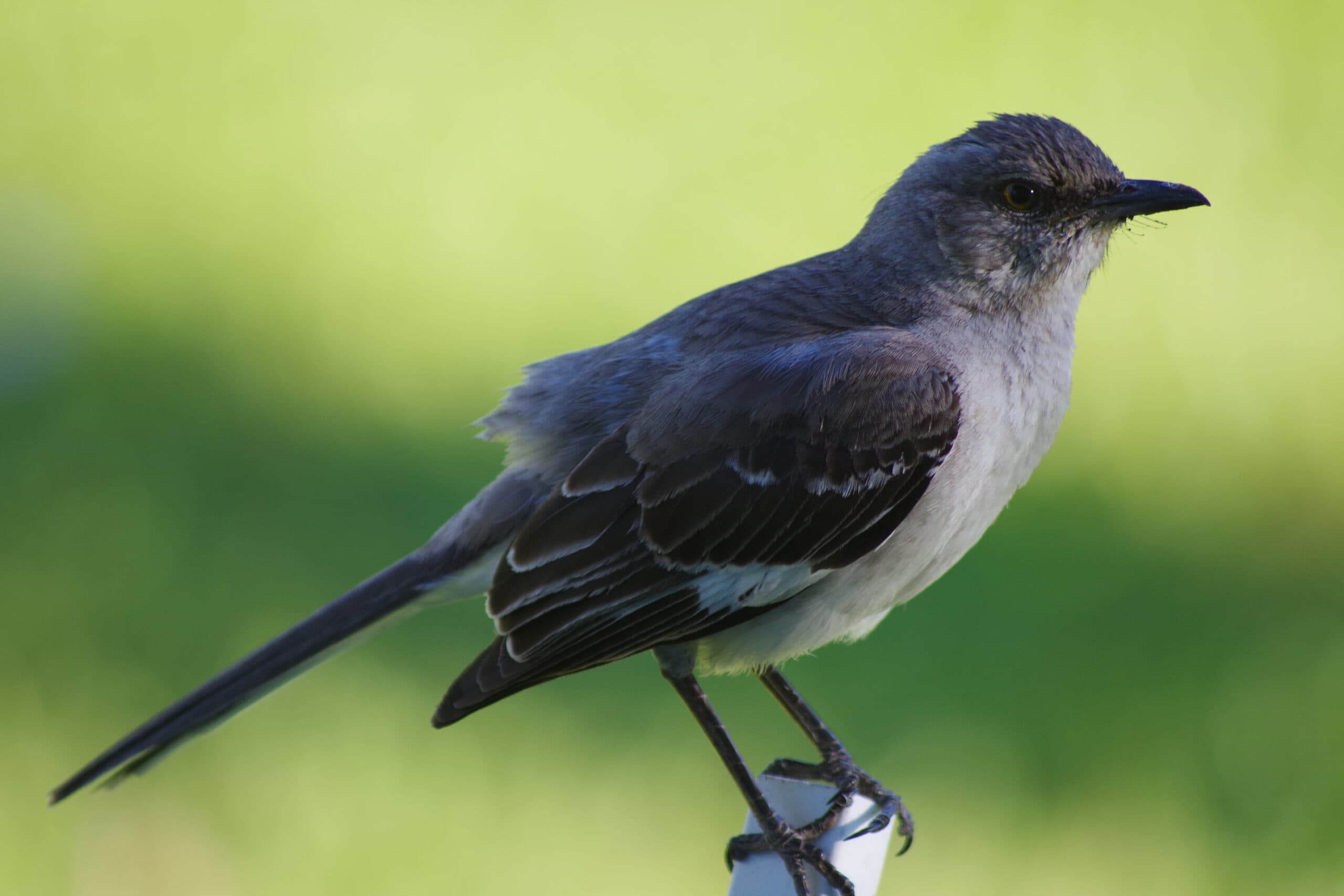
| Family: | Mimidae |
| Scientific Name: | Mimus gundlachi |
| Diet: | Berries, insects, and fruits. |
| Where They’re Found: | Cuba, Bahamas, and Jamaica. |
| Eggs Per Clutch: | 2–3 |
The Bahama Mockingbird is a small, grayish-brown bird with a long tail and a large white wing patch. It has a smooth outer wing feather and a slightly notched middle feather. Their bills are long and curved.
This bird is similar in appearance to the Northern Mockingbird but with darker plumage. They are gray-brown rather than gray and have darker gray bellies.
Like other mockingbirds, the Bahama Mockingbird is a territorial species that defends its nest sites against intruders.
During summer, the Bahama Mockingbird nests in low shrubs and bushes. The breeding season is from May through August, with some variation depending on location.
6. Socorro Mockingbird
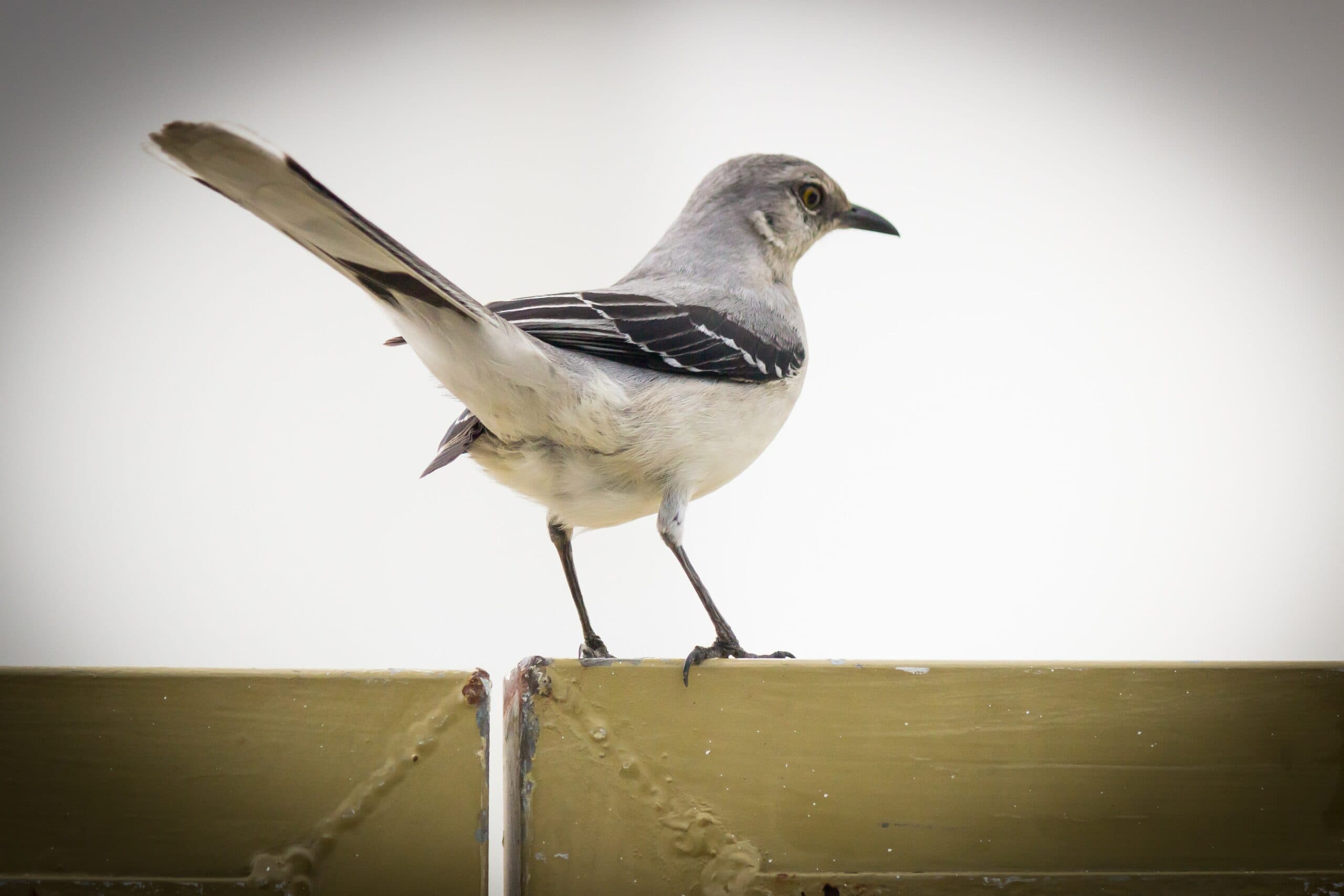
| Family: | Mimidae |
| Scientific Name: | Mimus graysoni |
| Diet: | Fruits, crab remains, and small invertebrates. |
| Where They’re Found: | Socorro in the Revillagigedo Islands of Mexico |
| Eggs Per Clutch: | 2–6 |
The Socorro Mockingbird is a species of mockingbird that lives on the Mexican island of Socorro. It’s endangered because its population has declined due to habitat loss and degradation.
Habitat loss occurs when a natural area is converted for different use.
The Socorro Mockingbird is gray-brown with a long tail and a straight, pointed beak. The male’s song consists of various whistles and warbles that can last 15 seconds.
Male Socorro Mockingbirds sing day and night. Their natural habitat is subtropical or tropical dry scrublands.
7. Patagonian Mockingbird
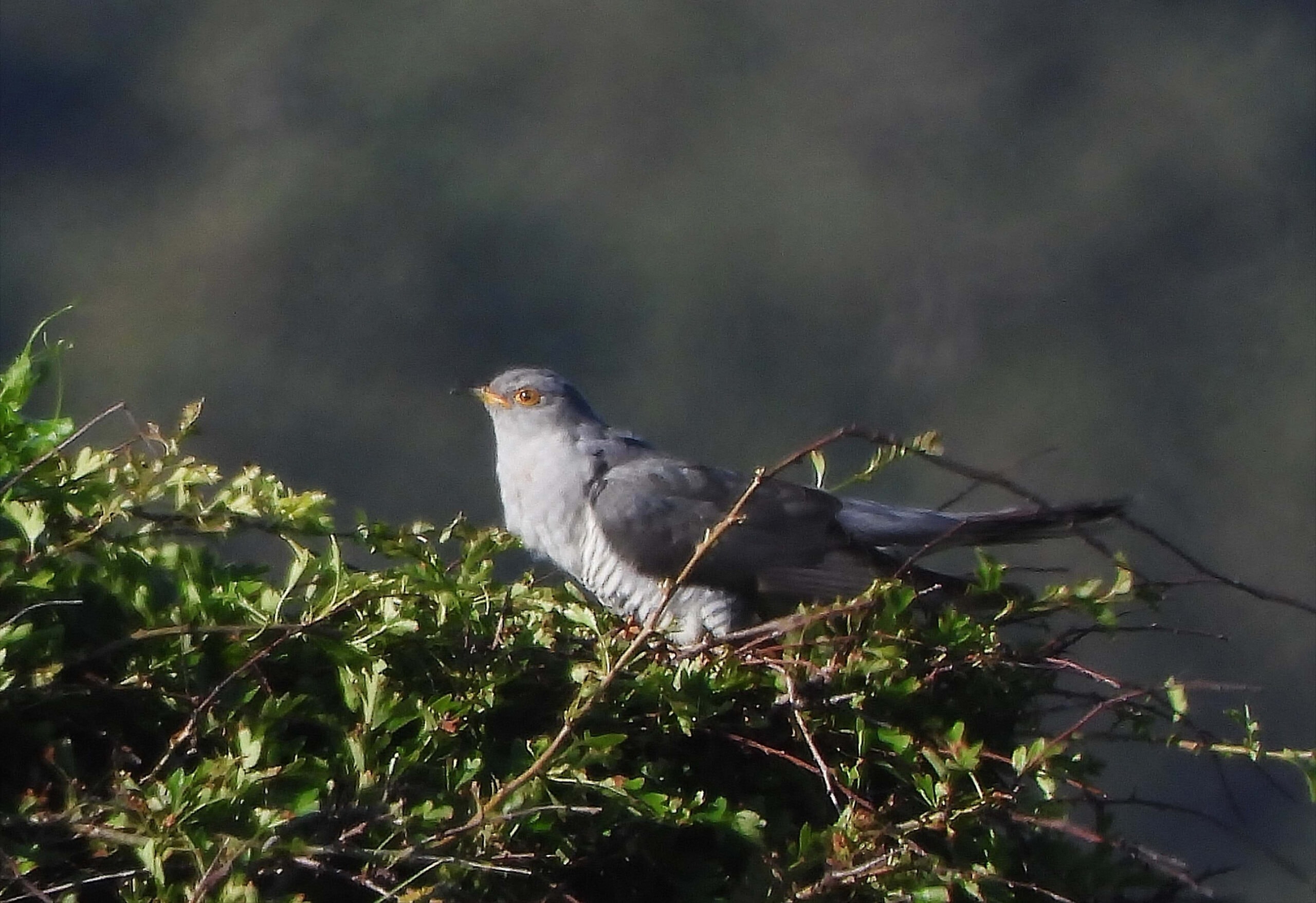
| Family: | Mimidae |
| Scientific Name: | Mimus patagonicus |
| Diet: | Mostly insects, berries, and fruits. |
| Where They’re Found: | Chile and Southern Argentina |
| Eggs Per Clutch: | 3–6 |
The Patagonian Mockingbird is an adaptable bird that lives near people. They have a gray-brown head, back, and chest. Their wings are olive-brown with dark bars and wingtips. The tail is also dark brown with white tips on some outer feathers.
The Patagonian Mockingbird has a wide range of vocalizations. They imitate other birds’ calls and mechanical sounds, such as car alarms or ringing telephones.
Patagonian Mockingbirds are omnivorous and eat both insects and fruits. These Mockingbirds also enjoy eating the berries of the mulberry tree.
8. Chilean Mockingbird
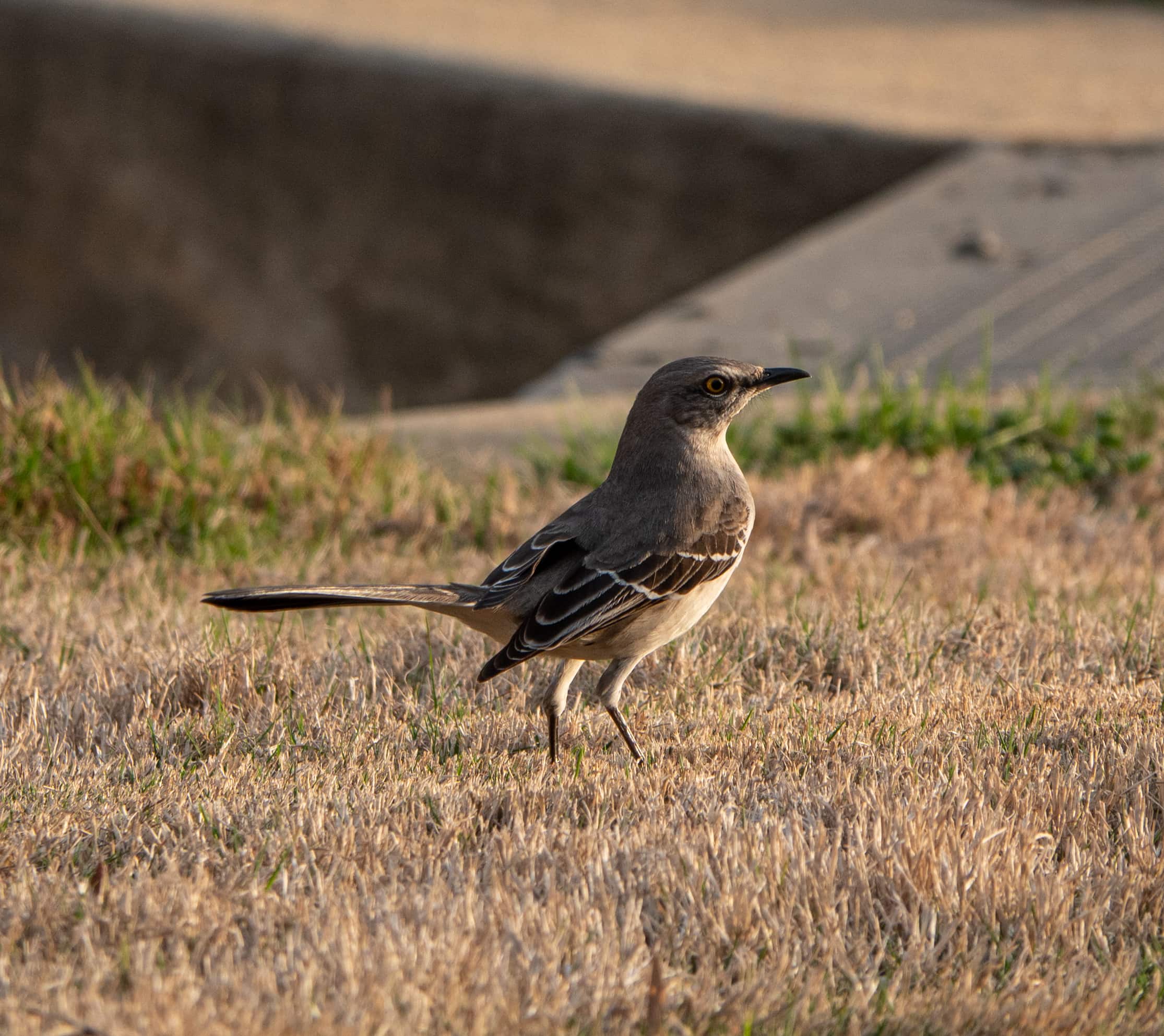
| Family: | Mimidae |
| Scientific Name: | Mimus thenca |
| Diet: | Nectar, small lizards, insects, and wild and cultivated fruits. |
| Where They’re Found: | Chile and Argentina |
| Eggs Per Clutch: | 2–4 |
The Chilean Mockingbird is a black-and-white bird that lives in Chile and Argentina. They have long, forked tails, which is their most distinctive feature. You can find them in forests, scrubby areas, and gardens.
These mockingbirds build their nests on the ground, in shrubs, or in bushes.
Once eggs have hatched, both parents feed the chicks for 2 weeks. After that, they are left to fend for themselves until they’re ready to fledge.
The Chilean Mockingbird is most active during the day. These birds are gregarious when roosting or feeding on the ground, but they’re solitary when perched in trees.
When singing from a perch, they will often lift their head feathers. Then, they spread their wings to impress rivals or potential mates.
9. Floreana Mockingbird

| Family: | Mimidae |
| Scientific Name: | Mimus trifasciatus |
| Diet: | Flying insects, terrestrial insects, centipedes, lizards, pollen, crabs, and fruits. |
| Where They’re Found: | Galapagos Islands |
| Eggs Per Clutch: | 2–6 |
A Floreana Mockingbird’s habitat is anywhere with open areas of low vegetation and grass because it allows for the easy hunting of insects. Usually, they nest in holes in trees, in cacti, or on bare, rocky slopes near their feeding grounds.
The most striking feature of this bird is its unusual plumage. Most birds in the mockingbird family have dull and muted colors. Still, the male Floreana Mockingbird’s feathers are bright orange and red with black markings along the wings and tail. The female birds have a different coloration from their mates, being much more brown than red.
These birds are territorial, especially when they breed between April and July. They will chase out other mockingbirds that enter their territory during this time.
The Floreana Mockingbird is known for its intricate song composed of small phrases repeated in quick succession. They also use these phrases to protect their territory.
10. Blue Mockingbird

| Family: | Mimidae |
| Scientific Name: | Melanotis caerulescens |
| Diet: | Fruits and insects |
| Where They’re Found: | Mexico, South America, and the Southern United States |
| Eggs Per Clutch: | 2–6 |
Blue Mockingbirds are most common in South America. They are small birds with a length of around 8 inches and weigh under 1 pound. They have blue feathers with black beaks. Both males and females look similar to one another.
Blue Hummingbirds are known for their ability to mimic other birds’ songs and various other sounds, including human voices and mechanical noises. They
live in moist forests with certain trees, such as pines, palms, and cypress. They prefer to nest near the ground but will sometimes nest in trees if necessary
11. Chalk-Browed Mockingbird

| Family: | Mimidae |
| Scientific Name: | Mimus saturninus |
| Diet: | Fruits, insects, and small vertebrates. |
| Where They’re Found: | Paraguay, Suriname, Brazil, Argentina, Uruguay, and parts of Bolivia. |
| Eggs Per Clutch: | 3–4 |
The Chalk-Browed Mockingbird measures 9 to 11 inches long and weighs under 1 pound. The adult plumage has a gray crown and nape, with darker feathers on the rear of the neck and upper mantle. The throat, breast, and belly are white.
This bird has a wide variety of loud calls. It includes whistles, gurgles, and rasps. Also, it mimics other species. Besides singing at dawn and dusk, it sings throughout the night during the breeding season.
The Chalk-Browed Mockingbird lives in open areas, especially where there are trees. It’s most common in farmlands and pastures, but it can also be seen in urban parks
12. Long-Tailed Mockingbird

| Family: | Mimidae |
| Scientific Name: | Mimus longicaudatus |
| Diet: | Berries, fruits, and marine and terrestrial invertebrates. |
| Where They’re Found: | Peru, Ecuador, and several parts of Chile in South America. |
| Eggs Per Clutch: | 3–4 |
Long-Tailed Mockingbirds are about 8.7 to 10.2 inches long. Adult birds have a gray head and back with white underparts.
Both sexes are similar in appearance, but the male’s tail is longer than its body. When flying, the bird displays broad wings and a fan-shaped tail with white outermost feathers.
These birds are also known for singing in several notes at once. They even mimic other bird species’ calls. They make a nest of grasses or other materials in trees or shrubs before the breeding season. Usually, they nest only once every 2 years unless there is severe drought or food shortage. When the female lays eggs, they’re incubated by both parents for about 1 month until they hatch.

Conclusion
Mockingbirds are common birds found in many parts of the world, and they are famous for their mimicry, especially of other birds. However, they can be very loud and aren’t everyone’s cup of tea.
Are you an ardent birder? Do you have a keen eye for detail? If so, the Mockingbird species featured above will give you plenty of reason to get out and explore your backyard. You might learn something new about the wildlife living just outside your back door.
Sources
Featured Image Credit: MOHANN, Pixabay
Table of Contents
About the Author Robert Sparks
Robert’s obsession with all things optical started early in life, when his optician father would bring home prototypes for Robert to play with. Nowadays, Robert is dedicated to helping others find the right optics for their needs. His hobbies include astronomy, astrophysics, and model building. Originally from Newark, NJ, he resides in Santa Fe, New Mexico, where the nighttime skies are filled with glittering stars.
Related Articles:
Monocular vs Telescope: Differences Explained (With Pictures)
10 Types of Hummingbirds in Arkansas (With Pictures)
8 Types of Hummingbirds in Nebraska (With Pictures)
5 Types of Hummingbirds in Idaho (With Pictures)
3 Types of Hummingbirds in Mississippi (With Pictures)
8 Types of Hummingbirds in Kansas (With Pictures)
5 Types of Hummingbirds in West Virginia (With Pictures)
5 Types of Hummingbirds in Ohio (With Pictures)
